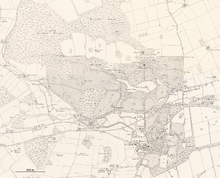Pitfour House

Pitfour House was a manor house north of the village of Old Deer in Aberdeenshire, Scotland. The mansion was canceled in 1926, of Pitfour Estate still exist the Vorwerk Saplinbrae House , the lake Pitfour Lake and parts of the park with the " Temple of Theseus " , a Gartenfolly . The ruins of Deer Abbey were also part of the property, which was one of the largest in Scotland.
history
James Ferguson (1735–1820) acquired the Pitfour estate around 1800 and, together with his nephew George Ferguson (1786–1867), an admiral, in the period up to 1850 put on the country estate with associated agriculture and a park. The family had grown wealthy from the West Indian sugar business.
The mansion was built in 1812, probably on the site of an older building. Most of the numerous other buildings are also likely to have been built in the following years. John Smith (1781-1852) worked as an architect from 1822 to 1831 , the design of the garden probably goes back to William Sawrey Gilpin (1762-1843). The project of a canal St Fergus and North Ugie Canal , operated by Admiral Ferguson, seemed to encounter technical difficulties (part preserved) and was finally abandoned with the construction of the railway in 1840.
In 1876 the son of Admiral Ferguson, George Arthur Ferguson (1835–1924) inherited the property. In 1919 Pitfour Estate was repeatedly offered for auction sale without success ; the area covered 8100 hectares . All documents relating to the Pitfour Estate and the Ferguson family have been lost since the mansion was abandoned.
Buildings
The mansion (1812, amendments in 1820) was in granite from Aberdeenshire in the style of neoclassicism ( classicism listed). The facades were severe and had little architectural ornamentation, the south side facing the park with the lake was largely glazed. A terraced garden in formal style with a central fountain followed. The building was demolished in 1926.
Other structures were: stables and farm buildings (1826), a riding school, a horse racing track, a private chapel with a low Gothic tower, and some cottages that formed a model village and were used to accommodate the employees. The center of the park was an artificially dammed body of water, The Lake (1816, today Pitfour Lake , 20 hectares) with three small islands, at the northwest end of which the Temple of Theseus , a staffage structure in the form of a reduced replica of the Athens Temple of Theseus (preserved) lies. A boathouse in the Gothic style is only a remnant of ruins.
The entrance to the park was a two-pillar memorial gates dedicated to Prime Minister Pitt and Scottish Minister Robert Dundas . In addition, the Fergusons had an observatory built and the ruins of the Deer Abbey in the south were converted into a kitchen garden, later a mausoleum (added entrance retained).
Literature and Sources
- Aberdeenshire Estate For Sale . In: The Times of April 3, 1919 (number 42065), page 15, column 2 below.
- Colonel Ferguson of Pitfour (Obituary) . In: The Times, September 17, 1924 (number 43837), page 16, column 3.
- John Young : Scotland's lost heritage . In: The Times, July 25, 1980 (number 60686), page 16, columns 3-6 (figure).
- AA Tait : The landscape garden and neoclassicism . In: Journal of garden history , Volume 3, 1983, pages 317-332, here: 322-332, with Figures 5-13.
Web links
- Temple of Theseus at risk: Buildings at risk
Coordinates: 57 ° 31 '56 " N , 2 ° 2' 17" W.
